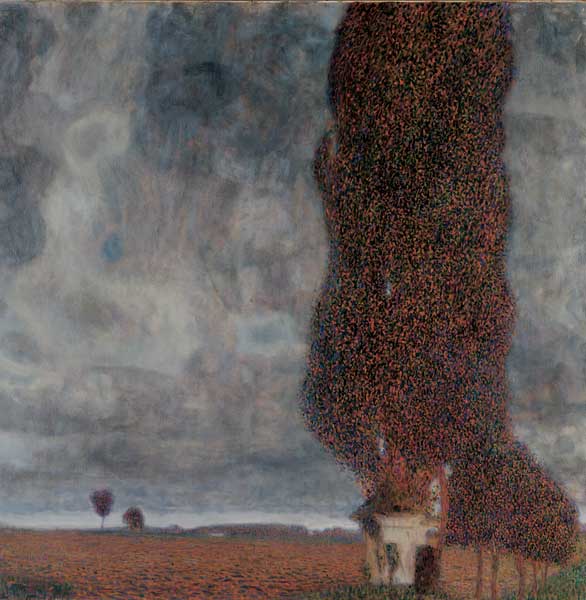Great Works: The Large Poplar (II) (1903), Gustav Klimt
Leopold Museum, Vienna

The Victorians enjoyed puzzle pictures. They liked upside-down images, for instance: one way up the picture showed a gay young lady, the other way up it showed a hideous crone. They liked visual puns, in which, with no rotation, an image could show now (say) a landscape, and now a face, depending on how you focused on it.
There was the anamorphic image, an unrecognisably stretched and curved picture, which through reflection in a cylindrical mirror could be revealed as a portrait or some other scene. Another kind of image was composed of dark, unreadable marks. Stare at it for a minute, turn your eyes away to a blank wall, and their negative image appeared: again some kind of face appears, usually.
These games, popular though they were, seldom occurred in fine art – or at least, not explicitly. But there are paintings that contain this kind of ambiguity. It's more than a trick or a joke. It's crucial to their performance. In this picture, for example, what visual play can you find?
Gustav Klimt's The Large Poplar (II) is also known as The Gathering Storm, and it is one of his geometrically contructed views. It makes an L-shaped (going backwards) composition. One arm is the land, going off to the left. The other is the poplar, going off at the top. As far as the picture is concerned, both are stretching on forever.
The storm is brewing. The light is going down over the autumnal ploughed field. The clouds in the sky are stirring turbulently, and two trees in the distance are feeling the winds that are getting up. In the midst of them, the monumental poplar stands. Klimt uses its verticality and its stiff close branches – its sides remain more or less parallel as it rises through the whole picture – to demonstrate its resisting strength as against the force of the storm.
And where is the ambiguity, then? Do you need to turn the picture upside down or explore it for hidden imagery? Must you view it through a cylindrical mirror? Or should you stare at it fixedly for minute etc? No, none of these exactly. The effect is... More obscure? More obvious?
Do a couple of imaginary operations. First, isolate the picture's bottom quarter. What have you got? A strip of panoramic landscape: the open field stretching to the horizon, and on the right a building and group of nearer trees. Nothing special about the view, except for the very wide, very low format.
Now do the complementary operation. Pay your attention to the rest of the picture, its upper three quarters. What can you tell about this area of the painting? What is it a picture of? Almost nothing. The sky becomes, not a field of cloud, but a dissolving, blotchy chaos. And the tree is unrecognisable. It is neither solid, nor flat – or both solid and flat. It's a vaguely fluid, flame-like, speckled form. It is a pretty well abstract element.
Of course, when the bottom-landscape is attached back onto the top-abstract, this vertical form acquires a trunk and a grounding. It takes shape, and makes sense. It becomes a tree. But without that foundation, it lacks any clear identity.
And even when the picture is entire, the tree is not entirely itself. It is a two-fold, simultaneous entity. It's on the one hand, a tall poplar, and on the other, it's a blob. Or rather, at a certain stage, as you move up – it's not very easy to tell where – it stops looking like a tree, an object in space, and becomes a blank mass.
The Large Poplar (II) is an odd kind of puzzle picture. It doesn't have the neat visual ambiguity that you find in some of them, where two images are fused together all through. Here, the two images are related by an overlap. Nor is the transition between one image and another. It's between an image and a non-image.
And this is where the power of this picture lies. What begins at ground level as a growing tree turns by the top of the picture into a meaningless bolt, condensing the force of the rising storm into a sheer inarticulate form – a something beyond our grasp, like nature itself.
About the artist
Gustav Klimt (1862-1918) is now one of the world's favourites, and his 'The Kiss' is among the most postered paintings around. Once, he was controversial. There was so much opposition to his paintings commissioned for Vienna University, the artist bought them back. But private clients relished his richly mixed pleasures. In portraits, landscapes, mythologies, Klimt piles it on. His painting is luxuriously ornamental, sex-saturated, stuffed with money, filled with gold leaf and saccharine hues and suggestions of holy icons and sensory delirium. It is a supremely consumeristic art, where every kind of delight, high and low, carnal, spiritual, is fused. It is now the epitome of Art Nouveau and fin-de-siècle Vienna. But it had to wait. It was only in the 1960s that these images with their smart graphics, their overt sexiness, their psychedelic glow, at last caught on.
Subscribe to Independent Premium to bookmark this article
Want to bookmark your favourite articles and stories to read or reference later? Start your Independent Premium subscription today.

Join our commenting forum
Join thought-provoking conversations, follow other Independent readers and see their replies